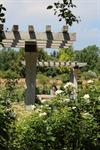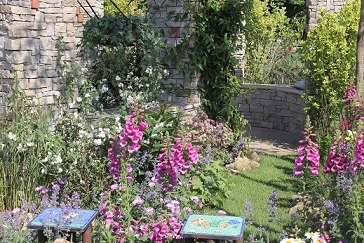
Take Your Landscaping Knowledge to the Next Level
Create those detailed individual components of the landscape that are the difference between a good and a great garden.
A garden is more then simply the plants we grow and the soil we grow them in. A garden comprises many other components that include furnishings, buildings, water features, fences, drainage and irrigation systems, paths, driveways, entertainment and other outdoor living areas.
Learn to make clever design choices
This course is perfect for those who wish to build on their pre-existing landscape design knowledge. It has an emphasis on the use of plants in design. Learn how microclimates influence design, how to select materials for use in the landscape, methods for choosing flowers, shrubs, climbers and trees in the landscape, types of structures and positioning them, and plants for specific purposes.
COURSE STRUCTURE
There are twelve lessons in this subject as follows:
1. The Garden Environment
2. Landscape Materials
3. Using Bulbs and Annuals
4. Landscaping with Trees
5. Ground Cover Plants
6. Walls and Fences
7. Paths and Paving
8. Treatment of Slopes and Other Problem Areas
9. Garden Features
10. Designing for Low Maintenance
11. Development of a Landscape Plan
12. Management of Landscape Projects
Course Aims
On completion of this course you should be able to:
- Determine the resources required for a landscape development, including materials and equipment.
- Determine appropriate plants for different locations within a landscape.
- Determine the appropriate design and construction for landscape features, including walls, fences, pavers and buildings.
- Determine treatments for problem areas in a landscape, including slopes and hostile environments.
- Analyse maintenance requirements for a landscape.
- Develop a landscape development plan, in accordance with a client brief, and in liaison with the client.
- Plan the management of a landscape projects.
 WHAT YOU WILL DO IN THIS COURSE
WHAT YOU WILL DO IN THIS COURSE
- Determine landscape materials readily available in the learners locality, including: soils, gravels, mulches and timbers.
- Differentiate between landscape applications for twenty different types of timber.
- Compare a range of materials in terms of function and aesthetics, including five types of mulches and five types of gravels.
- Determine applications for five different specific items of machinery in landscape construction including a chainsaw, an earth moving machine, a rotary hoe and a tractor.
- List minimum equipment required to construct two different landscapes in accordance with project specifications.
- Determine criteria for selecting plants to be planted in 3 specified locations.
- Explain the impact of trees in two specific landscapes, on both the environment and aesthetics of those landscapes.
- Determine twenty different herbaceous plants, to grow in three different specified locations within the same garden.
- Prepare a design for an annual flower display bed of 50 sq. metres.
- List five groundcovers suited to plant in four different situations, including full shade, half shade, full sun and hanging baskets.
- Prepare a planting design for a 100 sq. metre area of garden, using only ground covers and trees.
- List ten trees suited to each of the following cultural situations, in your locality: waterlogged soil; sandy soil; heavy soil; saline soil; fire prone sites and near drainage pipes.
- Explain local government regulations which are relevant to landscape design and construction.
- Develop design criteria for different garden structures, in specified situations, including: a pergola, swimming pool, steps and a garden seat.
- Compare the design and construction of six different types of barriers, including walls and fences.
- Design a fence for a landscape designed by you, including: construction detail drawing(s), materials specifications and a cost estimate.
- Compare ten specific surfacing materials, in landscapes visited by you, including paving products, stone and gravel.
- Design a set of steps, including construction detail drawing(s), materials specifications and a cost estimate.
- Design a set of retaining walls, including construction, drawings, materials needed and a cost estimate.
- Compare different types of garden buildings observed by you, including sheds, gazebos, car ports and garages, in terms of cost, durability, aesthetics and maintenance required.
- Determine two different methods to treat a specified erosion problem.
- Determine landscape preparations required for different soil types including clay, sand, shale, rocky soil and loam.
- Describe four interim stabilisation techniques, including hydromulching and jutemaster.
- List fifteen plant species which will adapt well to problem situations.
- Determine ten plants suitable for each of a range of different soil types, including: clays, sands, acidic soil and alkaline soil.
- Develop landscape plans, including illustrations and written instructions, for three difficult sites.
- Determine landscape features that contribute towards the reduction of maintenance requirement on a landscaped site.
- Compare the weekly maintenance requirement of a specific low maintenance garden, with that of a specific high maintenance garden.
- Compile pre-planning information for a an existing landscape, which owners require to be redeveloped in order to reduce the maintenance requirement.
- Prepare a detailed landscape design to achieve low maintenance.
- Develop a ten week maintenance program, for a specific landscaped area visited by you.
- Compare copies of two landscape briefs for projects advertised in the tenders column of a newspaper.
- Develop a "client" brief, through an interview with a potential landscape client.
- Survey a landscape site to confirm details in a client brief.
- Develop three alternative concept plans for a landscape, in accordance with a client brief.
- Determine the preferred option, from three concept plans presented to a client at a tape recorded meeting.
- Prepare a detailed landscape design, conforming to decisions made during a discussion of alternative concept plans.

- Prepare a quotation, based on a specified landscape plan.
- Analyse the design of a landscape in comparison with the "Brief".
- Prepare a work schedule according to both specifications and plans.
- Monitor the progress of landscape work on a project, by keeping a logbook or work diary.
- Assess standard of work carried out on a completed landscape project, against landscape plans for that project.
- Select appropriate equipment, including tools and machinery, for a specified project.
- List occupational health and safety regulations when dealing with machinery and equipment, which is relevant to a specified project.
- Schedule the supply of materials and equipment for a project, in the logbook.
- Develop contingency plans for a landscape development which addresses different possible irregularities including bad weather, security problems, weekend watering.
- Explain how to finalise a specified project prior to handing over.
- Explain the importance of monitoring a contract, through a specified project.
- Develop guidelines for supervision of construction for a specified landscape project.
How This Course Could Help You
This course is best suited to people with some existing knowledge of landscape design. However, people with basic construction skills and plant knowledge may also take it.
It could serve as a platform for further study or be taken in conjunction with other modules to enhance your learning experience. The course is of most value to people working in or wishing to work in:
- Landscape construction
- Garden Design
- Garden Maintenance
- Garden Restoration or Conservation
It could also add to the skill set of people wanting to start a garden design business, or be of value to people wishing to renovate a home garden.
WHAT NEXT?
Register to Study - Go to “It’s Easy to Enrol” box at the top of the page and you can enrol now.
or
Get Advice – Email us at info@acsedu.co.uk OR
Use our FREE COUNSELLING SERVICE to contact a tutor
CLICK TO CONTACT US